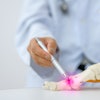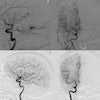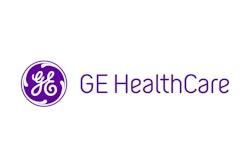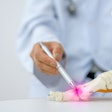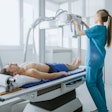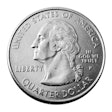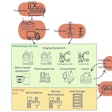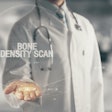New research from multiple radiology departments using both digital radiography (DR) and computed radiography (CR) found that even a cassetteless version of the latter requires more time to complete a standard chest x-ray. But DR's productivity came at a price, as it still costs $50,000 to $75,000 more per year to operate.
The two-part report, slated for the August issue of Radiology and currently available online, looked at four institutions: the Baltimore Veterans Affairs Medical Center in Maryland; the Memorial Sloan-Kettering Cancer Center in New York City; the Lahey Clinic Medical Center in Burlington, MA; and Westchester Medical Imaging Services, an outpatient facility in Hawthorne, NY.
The research was led by radiologist Dr. Bruce Reiner from the department of radiology at the Veterans Affairs Maryland Healthcare System and also the University of Maryland School of Medicine, both located in Baltimore.
Sites with different demographics and practices were specifically chosen, and all four were using both CR and DR in practice. Important technology variables included the inclusion of a cassetteless CR system at one site and the use of dedicated wall-mounted CR and DR units at two others, which limited the comparison to two-view chest x-ray exams.
The systems used at the institutions included three different CR systems (Fujifilm Medical Systems, Stamford, CT): the 9501, 5000 Plus, and SmartCR. The DR systems were a Revolution XQ/i (GE Healthcare, Chalfont St. Giles, U.K.) and an Epex (Hologic, Bedford, MA).
Trained timekeepers watched the technologists at each site and used stopwatches to clock the overall time per procedure and the time required for four segments of the process: patient preparation, positioning, exposure, and postacquisition processing. Outlier exams, in which systems went down or patients backed out, were excluded.
At all four sites, there was a statistically significant difference (p < 0.001) between total exam times, with CR taking an additional mean of 104.5 to 379.6 seconds. The most significant contributing factor was postacquisition processing time, accounting for 30% to 100% of the difference.
That said, the difference between CR and DR postacquisition processing times was quite consistent across the sites, ranging from 101.4 to 114.6 seconds. Thus, a number of other factors contributed to CR's time evaporation at the most inefficient sites.
An increased exposure time of 22.7 seconds with CR was found at one site, and waiting for batch-mode delivery of CR cassettes by radiology department aides was also a factor at one site. Departmental design and workflow factors included techs having to leave exam rooms to transport CR cassettes to the plate reader, and performing QA on central, shared-modality workstations while having in-room capabilities for DR.
"This idiosyncratic approach to workflow was observed in some instances at several of the sites and tended to adversely affect CR more than DR," the authors wrote.
Other examples that disproportionately affected CR included technologists entering data separately in both manual and electronic formats, and sitting idle while patients changed clothes.
"The most efficient CR technologists were found to multitask," the authors noted. "For example, a technologist working with a CR unit with in-room display and postprocessing capabilities could review and manipulate the first image acquired while simultaneously performing the second exposure for a two-view chest examination."
While cassetteless CR should save time by eliminating cassette transport and reducing image display time, inefficiencies in workflow were sufficient to negate that advantage, the authors noted.
Overall, the study indicates more substantial time differences between CR and DR than earlier reports, the authors noted. In particular, one previous study found two-view chest exams required 5.7 minutes by DR and 6.7 by CR; a similar study found times of 6 and 8 minutes respectively.
While the latest study found CR times comparable to earlier reports, with a range of 4.3 to 10.8 minutes, DR exam times had dropped to a range of 2.2 to 5.2 minutes. "This reduction in DR examination times is believed to be the result of advances in DR technology over the past few years, along with improvements in workflow-enhancing software programs (e.g., modality work-list programs)," the authors wrote.
Overall, the difference the researchers found between CR and DR was due to a number of factors, including department-specific workflow, departmental layout, technology implementation, staffing, and systems configuration.
"The most time-efficient sites were those that had in-room postacquisition processing capability and fully functional integration with the radiology information system," the authors wrote.
Although not stated by the authors, one reason that inefficiencies may be allowed is because these facilities don't have to operate up to capacity. That point comes out in the second Radiology report from the same group, which looked at CR and DR economics.
The excess annual cost for DR ranged from $50,757 to $75,303, the researchers found. "Although annualized equipment cost differences account for a substantial part of this disparity, a surprisingly large percentage (44.2% to 63.0%) of the cost differential is accounted for by annual service and maintenance costs," they wrote.
The cost of DR's increased productivity became justifiable when CR capacity utilization neared or exceeded 80%. Yet the four facilities examined were using only up to 37% of their CR capacity and only 25% of their DR capacity, the researchers found.
"It is noteworthy that most imaging departments (including the four participating sites in this study) do not electively schedule nonemergent general radiographic examinations," the authors wrote. "This policy can inadvertently decrease operational efficiency and increase the patient backlog."
Digital departments may also have a leftover "film bias" that causes them to convert all existing x-ray rooms without accounting for increased productivity, the authors suggested.
"On the basis of reported data, a film-to-digital radiographic room conversion ratio of 2:1 for CR and 3:1 for DR would be easily accommodated without increasing capacity utilization rates above 75%," they wrote.
"It is clear," they concluded, "that imaging departments that are planning a transition from (film-screen) to digital radiography should consider decreasing the number of rooms allocated to general radiography and should select technology on the basis of capacity utilization rates as well as the desired level of service to patients."
By Tracie L. Thompson
AuntMinnie.com staff writer
July 22, 2005
Related Reading
Ortho group stumbles with DR, completes conversion to digital CR, May 27, 2005
Preparation eases PACS' impact on technologists, March 1, 2005
New research shows CR more cost-effective than DR, February 28, 2005
Adding CT techs adds millions to bottom line, November 29, 2004
DR looks good in CR, film comparison study, September 19, 2003
Copyright © 2005 AuntMinnie.com
